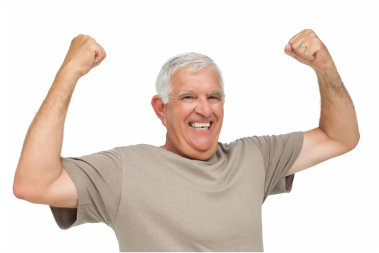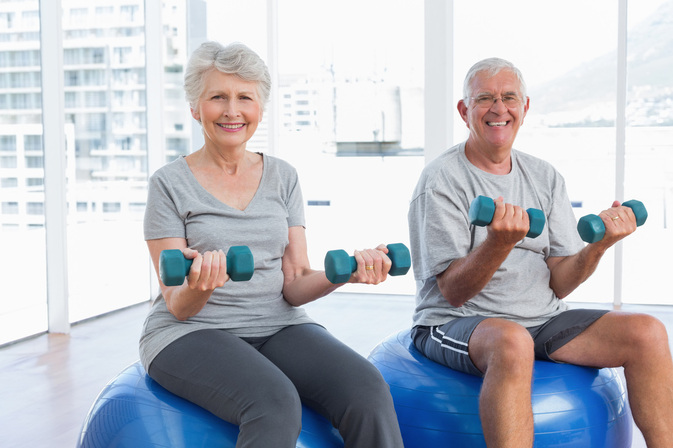
Regular exercise can help boost energy, maintain your
independence, and manage symptoms of illness or pain*
BENEFITS OF EXERCISE FOR THE AGING POPULATION*
Exercise reduces the impact of illness and chronic disease. Among the many benefits of exercise for adults over 50 include:
People who exercise also have a lowered risk of several chronic conditions including:
Exercise helps maintain or lose weight.
As metabolism naturally slows with age, maintaining a healthy weight is a challenge. Exercise helps:
When your body reaches a healthy weight, your overall wellness will improve.
Exercise enhances mobility, flexibility, and balance in older adults.
Exercise improves your strength, flexibility and posture, which in turn will help with balance, coordination, and reducing the risk of falls. Strength training also helps alleviate the symptoms of chronic conditions such as arthritis.
Exercise improves your sleep. Poor sleep is not an inevitable consequence of aging and quality sleep is important for your overall health. Exercise often improves sleep, helping you fall asleep more quickly and sleep more deeply.
Exercise boosts mood and self-confidence. Endorphins produced by exercise can actually help you feel better and reduce feelings of sadness or depression. Being active and feeling strong naturally helps you feel more self-confident and sure of yourself.
Exercise is good for the brain. Exercise benefits regular brain functions and can help keep the brain active, which can prevent memory loss, cognitive decline, and dementia. Exercise may even help slow the progression of brain disorders such as Alzheimer’s disease.
5 Myths about Exercise and Aging*
Myth 1: There’s no point to exercising. I’m going to get old anyway.
Fact: Exercise and strength training helps you look and feel younger and stay active longer. Regular physical activity lowers your risk for a variety of conditions, including Alzheimer’s and dementia, heart disease, diabetes, colon cancer, high blood pressure, and obesity.
Myth 2: Older people shouldn't exercise. They should save their strength and rest.
Fact: Research shows that a sedentary lifestyle is unhealthy for adults over 50. Inactivity often causes older adults to lose the ability to do things on their own and can lead to more hospitalizations, doctor visits, and use of medicines for illnesses.
Myth 3: Exercise puts me at risk of falling down.
Fact: Regular exercise, by building strength and stamina, prevents loss of bone mass and improves balance, actually reducing your risk of falling.
Myth 4: It’s too late. I’m already too old to start exercising.
Fact: You’re never too old to exercise! If you've never exercised before, or it’s been a while, start with light walking and other gentle activities.
Myth 5: I’m disabled. I can’t exercise sitting down.
Fact: Chair-bound people face special challenges but can lift light weights, stretch, and do chair aerobics to increase range of motion, improve muscle tone, and promote cardiovascular health.
http://www.helpguide.org/articles/exercise-fitness/exercise-and-fitness-as-you-age.htm
- Maintain independence
- Improve quality-of-life
- Prevent injury due to osteoporosis
- Reduce the risk of heart disease
- Decrease the risk of fall by improving balance
BENEFITS OF EXERCISE FOR THE AGING POPULATION*
Exercise reduces the impact of illness and chronic disease. Among the many benefits of exercise for adults over 50 include:
- improved immune function
- better heart health and blood pressure
- better bone density
- better digestive functioning.
People who exercise also have a lowered risk of several chronic conditions including:
- Alzheimer’s disease
- diabetes
- obesity
- heart disease
- osteoporosis
- colon cancer.
Exercise helps maintain or lose weight.
As metabolism naturally slows with age, maintaining a healthy weight is a challenge. Exercise helps:
- increase metabolism
- builds muscle mass
- burn more calories.
When your body reaches a healthy weight, your overall wellness will improve.
Exercise enhances mobility, flexibility, and balance in older adults.
Exercise improves your strength, flexibility and posture, which in turn will help with balance, coordination, and reducing the risk of falls. Strength training also helps alleviate the symptoms of chronic conditions such as arthritis.
Exercise improves your sleep. Poor sleep is not an inevitable consequence of aging and quality sleep is important for your overall health. Exercise often improves sleep, helping you fall asleep more quickly and sleep more deeply.
Exercise boosts mood and self-confidence. Endorphins produced by exercise can actually help you feel better and reduce feelings of sadness or depression. Being active and feeling strong naturally helps you feel more self-confident and sure of yourself.
Exercise is good for the brain. Exercise benefits regular brain functions and can help keep the brain active, which can prevent memory loss, cognitive decline, and dementia. Exercise may even help slow the progression of brain disorders such as Alzheimer’s disease.
5 Myths about Exercise and Aging*
Myth 1: There’s no point to exercising. I’m going to get old anyway.
Fact: Exercise and strength training helps you look and feel younger and stay active longer. Regular physical activity lowers your risk for a variety of conditions, including Alzheimer’s and dementia, heart disease, diabetes, colon cancer, high blood pressure, and obesity.
Myth 2: Older people shouldn't exercise. They should save their strength and rest.
Fact: Research shows that a sedentary lifestyle is unhealthy for adults over 50. Inactivity often causes older adults to lose the ability to do things on their own and can lead to more hospitalizations, doctor visits, and use of medicines for illnesses.
Myth 3: Exercise puts me at risk of falling down.
Fact: Regular exercise, by building strength and stamina, prevents loss of bone mass and improves balance, actually reducing your risk of falling.
Myth 4: It’s too late. I’m already too old to start exercising.
Fact: You’re never too old to exercise! If you've never exercised before, or it’s been a while, start with light walking and other gentle activities.
Myth 5: I’m disabled. I can’t exercise sitting down.
Fact: Chair-bound people face special challenges but can lift light weights, stretch, and do chair aerobics to increase range of motion, improve muscle tone, and promote cardiovascular health.
http://www.helpguide.org/articles/exercise-fitness/exercise-and-fitness-as-you-age.htm
